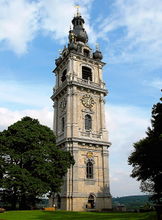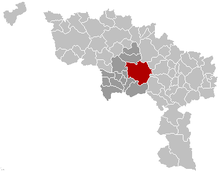Mons
| Mons | ||||||
|---|---|---|---|---|---|---|
 |
||||||
|
||||||
 |
||||||
 Mons
Location in Belgium
|
||||||
| Sovereign state | ||||||
| Region | ||||||
| Community | ||||||
| Province | ||||||
| Arrondissement | Mons | |||||
| Coordinates | ||||||
| Area | 146.56 km² | |||||
| Population – Males – Females – Density |
91,221 (2006-01-01) 47.78% 52.22% 623 inhab./km² |
|||||
| Unemployment rate | 25.96% (1 January 2006) | |||||
| Mean annual income | €11,012/pers. (2003) | |||||
| Mayor | Elio Di Rupo (PS) | |||||
| Governing parties | PS, MR | |||||
| Postal codes | 7000-7034 | |||||
| Area codes | 065 | |||||
| Website | www.mons.be | |||||
Mons (French pronunciation: [mɔ̃s]; Dutch: Bergen; Picard: Mont) is a Walloon city and municipality located in the Belgian province of Hainaut, of which it is the capital. The Mons municipality includes the old communes of Cuesmes, Flénu, Ghlin, Hyon, Nimy, Obourg, Baudour (partly), Jemappes, Ciply, Harmignies, Harveng, Havré, Maisières, Mesvin, Nouvelles, Saint-Denis, Saint-Symphorien, Spiennes, Villers-Saint-Ghislain, Casteau (partly), Masnuy-Saint-Jean (partly), and Ville-sur-Haine (partly).
Contents |
History
Early settlements to the Middle Ages

The first signs of activity in the region of Mons can be found at Spiennes, where some of the best flint tools in Europe were found dating from the Neolithic period. When Julius Caesar arrived in the region in the 1st century BC, the region was settled by the Nervii. A castrum was built in Roman times, giving the settlement its first Latin name Castrilocus; the name was later changed into Montes for the hills on which the castrum was built. In the 7th century, Saint Ghislain and two of his disciples built an oratory or chapel dedicated to Saints Peter and Paul near the Mons hill, at a place called Ursidongus, now known as Saint-Ghislain. Soon after, Saint Waltrude (in French Sainte Waudru), daughter of one of Clotaire II’s intendants, came to the oratory and was proclaimed a saint upon her death in 688. She was canonized in 1039.
Like Ath, its neighbour to the north-west, Mons was made a fortified city by Baldwin IV, Count of Hainaut in the 12th century. The population grew quickly, trade flourished, and several commercial buildings were erected near the Grand’Place. The 12th century also saw the appearance of the first town halls. The city had 4,700 inhabitants by the end of the 13th century. Mons succeeded Valenciennes as the capital of the county of Hainaut in 1295 and grew to 8,900 inhabitants by the end of the 15th century. In the 1450s, Matheus de Layens took over the construction of the Saint Waltrude church from Jan Spijkens and restored the town hall.

From 1500 to 1800
In 1515, Charles V took an oath in Mons as Count of Hainaut. In this period of its history, the city became the target of various occupations, starting in May 1572 with the Protestant takeover by Louis of Nassau, who had hoped to clear the way for the French Protestant leader Gaspard de Coligny to oppose Spanish rule. After the murder of de Coligny during the St. Bartholomew's Day massacre, the Duke of Alba took control of Mons in September of 1572 in the name of the Catholic King of Spain. This spelled the ruin of the city and the arrest of many of its inhabitants; from 1580 to 1584, Mons became the capital of the Southern Netherlands.
On April 8, 1691, after a nine-month siege, Louis XIV’s army stormed the city, which again suffered heavy casualties. From 1697 to 1701, Mons was alternately French or Austrian. After being under French control from 1701 to 1709, the Dutch army gained the upper hand in the Battle of Malplaquet. In 1715, Mons returned to Austria under the terms of the Treaty of Utrecht (1713). But the French did not give up easily; Louis XV besieged the city again in 1746. After the Battle of Jemappes (1792), the Hainaut area was annexed to France and Mons became the capital of the Jemappes district.
From 1800 to the present


Following the fall of the First French Empire in 1814, King William I of the Netherlands fortified the city heavily. In 1830, however, Belgium gained its independence and the decision was made to dismantle fortified cities such as Mons, Charleroi, and Namur. The actual removal of fortifications only happened in the 1860s, allowing the creation of large boulevards and other urban projects. The Industrial Revolution and coal mining made Mons a center of heavy industry, which strongly influenced the culture and image of the Borinage region as a whole. It was to become an integral part of the sillon industriel, the industrial backbone of Wallonia.
Riots of Mons
In 1893 (17 April), between Mons and Jemappes, seven strikers were killed by the civic guard at the end of the Belgian general strike of 1893.
The proposal law on universal suffrage was approved the day after by the Belgian Parliament.
This General strike was one of the first general strikes in an industrial country.
Battle of Mons
On August 23 and 24, 1914, Mons was the site of the first battle fought by the British Army in World War I. The British were forced to retreat and the town was occupied by the Germans, until its liberation by the Canadian Corps during the final days of the war. As an important industrial centre, the city was heavily bombed and several skirmishes took place in September 1944 between the American troops and the retreating German forces. After the war, most industries went into decline.
NATO's Supreme Headquarters Allied Powers Europe (SHAPE) was relocated in Casteau, a village near Mons, from Fontainebleau after France's withdrawal from the military structure of the alliance in 1967. The relocation of SHAPE to this particular region of Belgium was largely a political decision, based in large part on the depressed economic conditions of the area at the time with the view to bolstering the economy of the region. A riot in the prison of Mons took place in April 2006 after prisoner complaints concerning living conditions and treatment; no deaths were reported as a result of the riot, but the event focused attention on prisons throughout Belgium. Today, the city is an important university town and commercial centre.
Main sights


- The Grand Place is the centre of the historic town and the stage for the annual mock-battle of the Lumeçon.
- The City Hall, originally built near the current location of the belfry, was moved on the Grand Place in the 13th century. The flamboyant gothic building we see today dates from the 15th century. In front of it stands a statue of a monkey, which is said to bring good fortune to those who pat his head.
- The collegiate church of Saint Waltrude is paradoxically a good specimen of the Gothic architecture of Brabant.
- The neighbouring belfry, classified as a World Heritage Site, dates from the 17th century and is the only Baroque-style belfry in Belgium.
- The so-called Spanish House dates from the 16th century.
Festivities
- The Doudou is the name of a week-long series of festivities or Ducasse, which originates from the 14th century and takes place every year on Trinity Sunday. Highlights include:
- The entrusting of the reliquary of Saint Waltrude to the mayor of the city on the eve of the procession.
- The placement of the reliquary on the Car d’Or (golden carriage), before it is carried in the city streets in a colourful procession that counts more than a thousand costumed participants.
- The lifting of the Car d’Or on a paved area near the church of Saint Waltrude; tradition holds that this operation must be successful for the city to prosper.
- The Lumeçon fight, where Saint George confronts the dragon. The fight lasts for about half an hour, accompanied by the rhythmic "Doudou" music. The tradition of the processional dragon is listed among the Masterpieces of the Oral and Intangible Heritage of Humanity.
Education
There are 3 universities and one conservatory in Mons. They are:
- Faculté polytechnique de Mons or FPMs
- Facultés universitaires catholiques de Mons or FUCAM (pronounced "fu cahm")
- Université de Mons-Hainaut or UMH
- Conservatoire Royal de Mons or CRM
Transportation
Mons is located along N56 road.
Sports
The town hosts a football club named R.A.E.C. Mons.
People born in Mons
- Gilles Binchois, composer (15th century, birth in Mons is uncertain)
- Jan Provoost, painter (15th-16th century)
- Jacques du Broeucq, painter and architect (16th century, birth in Mons is uncertain)
- Orlande de Lassus, composer (16th century)
- Guido de Bres, theologian (1522 to 31 May 1567)
- Nicolas Neufchatel, painter (16th century)
- Jean Yeuwain, writer (16th - 17th century)
- Giuseppe Grisoni, painter and sculptor (17th century)
- François-Joseph Fétis, musicologist, composer, critic, and teacher (18th century)
- François-Philippe de Haussy, first governor of the National Bank of Belgium (18th century)
- Paul Émile de Puydt, botanist, economist, and writer (19th century)
- Émile Motte, painter (19th century)
- Louis Dewis, painter (19th century)
- Charles Plisnier, Walloon writer, Prix Goncourt and Walloon movement activist
Twin cities
 France: Briare
France: Briare France: Thoissey
France: Thoissey France: Vannes
France: Vannes United Kingdom: Sefton
United Kingdom: Sefton China: Changsha
China: Changsha United States: Little Rock, Arkansas
United States: Little Rock, Arkansas
See also
- Battle of Mons, 1914
- Angels of Mons
- Mons Meg
- Grand Hornu
- Initialis Science Park
- Mundaneum (Paul Otlet)
- Borinage
External links
- Cercle Archéologique de Mons, an exhaustive list of references on the history of the Mons region, in French.
- Official site of the city, in French.
- Official site of the Doudou, in French.
- Unofficial site of the Doudou (Text ; Movies ; Music..., in French.
- The World Heritage Flint mines in Spiennes, in French (summary in English).
- Conservatoire Royal de Mon, posted by Gerard Epure, in French
|
|||
|
Mons · Ciply · Cuesmes · Flénu · Ghlin · Harmignies · Harveng · Havré · Hyon · Jemappes · Maisières · Mesvin · Nimy · Nouvelles · Obourg · Saint-Denis · Saint-Symphorien · Spiennes · Villers-Saint-Ghislain |
|
|||||||||||||||||||||||||

.svg.png)
